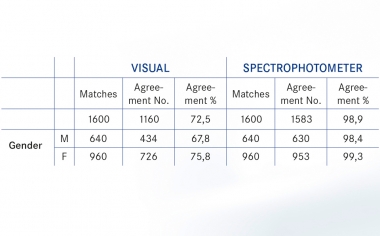VITA Zahnfabrik
H. Rauter GmbH & Co. KG
Spitalgasse 3
79713 Bad Säckingen

Digital tooth shade determination is significantly more precise than visual determination
Uptil now, tooth shade in dentistry has mainly been determined by visually comparing a shade tab with the natural tooth. However, visual shade determination is influenced by numerous factors, such as the subjective shade perception of the observer, the lighting conditions and the surface structure of the teeth. With digital shade measuring devices, potential sources of error can be eliminated. One study shows that tooth shade can be more reliably determined with the digital spectrophotometer VITA Easyshade (VITA Zahnfabrik, Bad Säckingen, Germany), than with visual tooth shade determination using a shade guide. Dentist PD Dr. Karl Martin Lehmann (Johannes Gutenberg University, Policlinic for Dental Prosthetics and Material Science, Director: Univ.-Prof. H. Scheller, Mainz, Germany) reports on the study results in an interview and provides suggestions for everyday issues in dental practices and laboratories.
DV: What was your goal in investigating both procedures for shade determination?
Dr. Karl Lehmann: The goal of the study was to determine how reliably and reproducibly male and female study participants can determine tooth shades using visual and digital processes. To do this, 100 subjects determined the shades of standardized VITA classical A1-D4 tooth shade tabs in various sessions under ideal lighting conditions, both visually and digitally.
DV: How exactly did you proceed with this investigation?
Dr. Karl Lehmann: In the first step of this investigation, the subjects had to visually determine the tooth shades of 16 previously anonymized VITA classical A1-D4 shade tabs using the VITA classical A1-D4 shade guide and, in a second step, perform the procedure again digitally with the VITA Easyshade spectrophotometer. Each participant had a maximum of eight seconds to determine the tooth shade. A total of 3200 visual and digital shade determinations were made.
DV: What differences were you able to determine between the digital and visual methods?
Dr. Karl Lehmann: In the digital procedure with the spectrophotometer VITA Easyshade, the correct tooth shade was determined in nearly 100 percent of the measurements. This showed a significantly greater precision for the digital procedure than for the visual method. When using the shade guide, the subjects determined the correct tooth shade in only about 72 percent of the shade determinations. The gender-specific analysis showed that female subjects recognized the shade of the teeth in the visual shade determination more often than male participants. In contrast, there was no significant difference in the digital shade determination.
DV: What recommendations can be derived from these results for dentists and technicians?
Dr. Karl Lehmann: Due to the high precision of the digital method, the tooth shade determination should be as digital as possible, ideally complemented by photos of the intraoral situation of the respective patient, which can provide further information on shape design and surface structures. Detailed information enables the dental laboratory to produce a high-precision, true-to-life shade reproduction. With such tooth shade and image information, additional time and expense due to subsequent shade corrections or even completely new productions, can be avoided.
DV: What should dentists and dental technicians watch out for with digital shade determination?
Dr. Karl Lehmann: In principle, operating the VITA Easyshade is self-explanatory and very simple. You should just make sure that the measurement is carried out before the start of treatment and that the measuring tip rests perfectly flat on the tooth surface. Thanks to the use of standardized LED white light, neither the influence of the lighting conditions, nor the surrounding colors has to be considered.
Report 07/19
PD Dr. Karl Martin Lehmann, Mainz, Germany

Fig. 1 The results graph shows a shade match of > 98 percent (all subjects) for digital shade determination. On the other hand, with visual shade determination, a shade match of only > 70 percent was achieved (all subjects).
Source: Lehmann K, Devigus A, Wentaschek S, Igiel C, Scheller H, Paravina R.Comparison of visual shade matching and electronic color measurement device.Int J Esthet Dent. 2017;12(3):396-404.